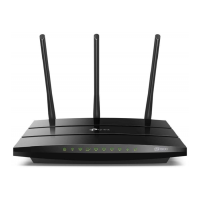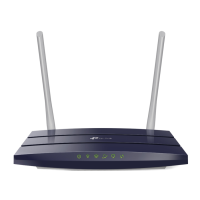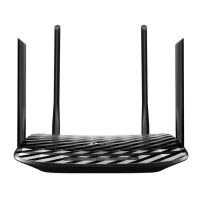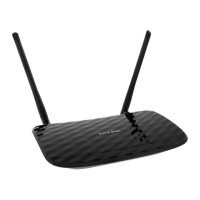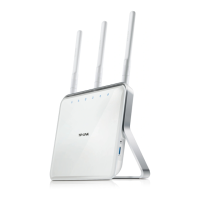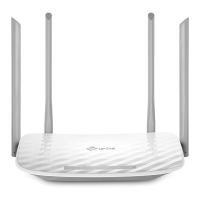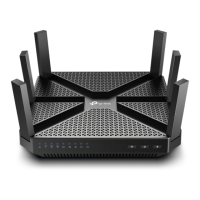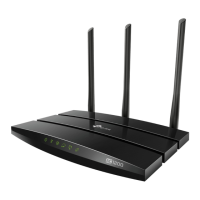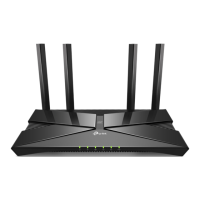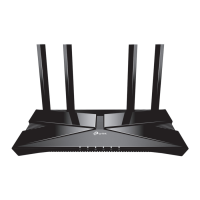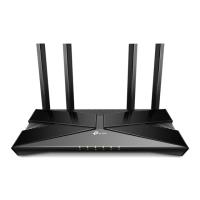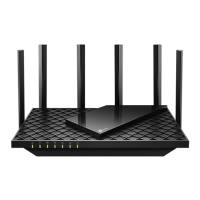Do you have a question about the TP-Link Archer XR500v and is the answer not in the manual?
Explains formatting, icons, and text conventions used throughout the user guide.
Lists essential links for downloads, support forums, and technical assistance.
Details the router's integrated functions, performance capabilities, and connectivity options.
Describes the router's external layout, including LEDs, ports, and buttons for identification.
Provides guidelines for optimal router placement to ensure strong Wi-Fi signal and network security.
Step-by-step instructions for physically connecting the router to power, the network, and client devices.
Guides users on launching a browser, entering the router's address, and setting initial login credentials.
Utilizes an automated wizard for streamlined internet connection configuration.
Manually enters ISP-provided parameters like GPON SN and password for connection.
Uses built-in diagnostic tools to verify the successful establishment of an internet connection.
Sets up an IPv6 connection, either manually or through the quick setup process.
Connects telephones and inputs VoIP service provider details for basic telephony functions.
Creates and organizes contacts, sets speed dial numbers, and configures emergency call features.
Assigns specific incoming/outgoing numbers to telephony devices and manages ring behavior.
Reviews call history, establishes call rules, and utilizes blocking features like DND.
Configures call forwarding rules and enables making calls via the router's telephony number.
Enables and configures voicemail services, including remote access and message playback options.
Provides methods for accessing files on USB drives connected to the router via network or internet.
Enables sharing media files from USB devices for playback on DLNA-compatible devices.
Sets up a 3G/4G USB modem for internet access, including failover functionality.
Implements rules to block specific websites or limit internet access for devices during certain times.
Enables QoS and configures queue parameters to prioritize traffic and manage bandwidth efficiently.
Creates and manages data classification rules and applies filter settings to prioritize specific traffic types.
Activates the SPI firewall and adjusts DoS protection levels to safeguard the network from attacks.
Blocks unwanted services and controls device access using blacklists or whitelists.
Binds IP addresses to MAC addresses to prevent unauthorized access and spoofing.
Configures ALG protocols to facilitate address and port translation for applications like FTP and SIP.
Establishes virtual servers to share local network services, such as websites, over the internet.
Sets up triggering ports to dynamically open external ports for games, VoIP, and other applications.
Designates a device as a DMZ host, exposing it to the internet for unrestricted communication.
Enables Universal Plug and Play for seamless online gaming and applications requiring automatic port forwarding.
Manages LAN IP addresses, DHCP server functions, and IP address reservations.
Configures IPv6 address assignment methods like RADVD and DHCPv6 server.
Customizes wireless network name (SSID), password, security, mode, channel, and WPS settings.
Configures a DDNS account for remote router access using a domain name instead of IP address.
Defines static routes to control data packet paths for accessing specific networks or hosts.
Establishes IPv6 tunnels (6to4, 6rd) to provide IPv6 connectivity over an IPv4 network.
Sets and synchronizes the router's system time and configures daylight saving rules.
Updates router firmware and performs backup and restore operations for configuration settings.
Changes the administrator account credentials for secure access to the router's web interface.
Configures access control for managing the router locally and remotely, including secure HTTPS access.
Reviews system logs for troubleshooting and monitors network traffic statistics for performance analysis.
Configures CWMP settings for automated device management and diagnostics via an ACS server.
Restores router to factory defaults and provides methods for recovering forgotten web management passwords.
Addresses issues with logging into the router and resolving problems with internet connectivity.
Guides on MAC address cloning and troubleshooting wireless network discovery and connection problems.
Explains how to configure computer settings to obtain IP addresses automatically via DHCP.
Explains formatting, icons, and text conventions used throughout the user guide.
Lists essential links for downloads, support forums, and technical assistance.
Details the router's integrated functions, performance capabilities, and connectivity options.
Describes the router's external layout, including LEDs, ports, and buttons for identification.
Provides guidelines for optimal router placement to ensure strong Wi-Fi signal and network security.
Step-by-step instructions for physically connecting the router to power, the network, and client devices.
Guides users on launching a browser, entering the router's address, and setting initial login credentials.
Utilizes an automated wizard for streamlined internet connection configuration.
Manually enters ISP-provided parameters like GPON SN and password for connection.
Uses built-in diagnostic tools to verify the successful establishment of an internet connection.
Sets up an IPv6 connection, either manually or through the quick setup process.
Connects telephones and inputs VoIP service provider details for basic telephony functions.
Creates and organizes contacts, sets speed dial numbers, and configures emergency call features.
Assigns specific incoming/outgoing numbers to telephony devices and manages ring behavior.
Reviews call history, establishes call rules, and utilizes blocking features like DND.
Configures call forwarding rules and enables making calls via the router's telephony number.
Enables and configures voicemail services, including remote access and message playback options.
Provides methods for accessing files on USB drives connected to the router via network or internet.
Enables sharing media files from USB devices for playback on DLNA-compatible devices.
Sets up a 3G/4G USB modem for internet access, including failover functionality.
Implements rules to block specific websites or limit internet access for devices during certain times.
Enables QoS and configures queue parameters to prioritize traffic and manage bandwidth efficiently.
Creates and manages data classification rules and applies filter settings to prioritize specific traffic types.
Activates the SPI firewall and adjusts DoS protection levels to safeguard the network from attacks.
Blocks unwanted services and controls device access using blacklists or whitelists.
Binds IP addresses to MAC addresses to prevent unauthorized access and spoofing.
Configures ALG protocols to facilitate address and port translation for applications like FTP and SIP.
Establishes virtual servers to share local network services, such as websites, over the internet.
Sets up triggering ports to dynamically open external ports for games, VoIP, and other applications.
Designates a device as a DMZ host, exposing it to the internet for unrestricted communication.
Enables Universal Plug and Play for seamless online gaming and applications requiring automatic port forwarding.
Manages LAN IP addresses, DHCP server functions, and IP address reservations.
Configures IPv6 address assignment methods like RADVD and DHCPv6 server.
Customizes wireless network name (SSID), password, security, mode, channel, and WPS settings.
Configures a DDNS account for remote router access using a domain name instead of IP address.
Defines static routes to control data packet paths for accessing specific networks or hosts.
Establishes IPv6 tunnels (6to4, 6rd) to provide IPv6 connectivity over an IPv4 network.
Sets and synchronizes the router's system time and configures daylight saving rules.
Updates router firmware and performs backup and restore operations for configuration settings.
Changes the administrator account credentials for secure access to the router's web interface.
Configures access control for managing the router locally and remotely, including secure HTTPS access.
Reviews system logs for troubleshooting and monitors network traffic statistics for performance analysis.
Configures CWMP settings for automated device management and diagnostics via an ACS server.
Restores router to factory defaults and provides methods for recovering forgotten web management passwords.
Addresses issues with logging into the router and resolving problems with internet connectivity.
Guides on MAC address cloning and troubleshooting wireless network discovery and connection problems.
Explains how to configure computer settings to obtain IP addresses automatically via DHCP.
| Brand | TP-Link |
|---|---|
| Model | Archer XR500v |
| Category | Network Router |
| Language | English |
